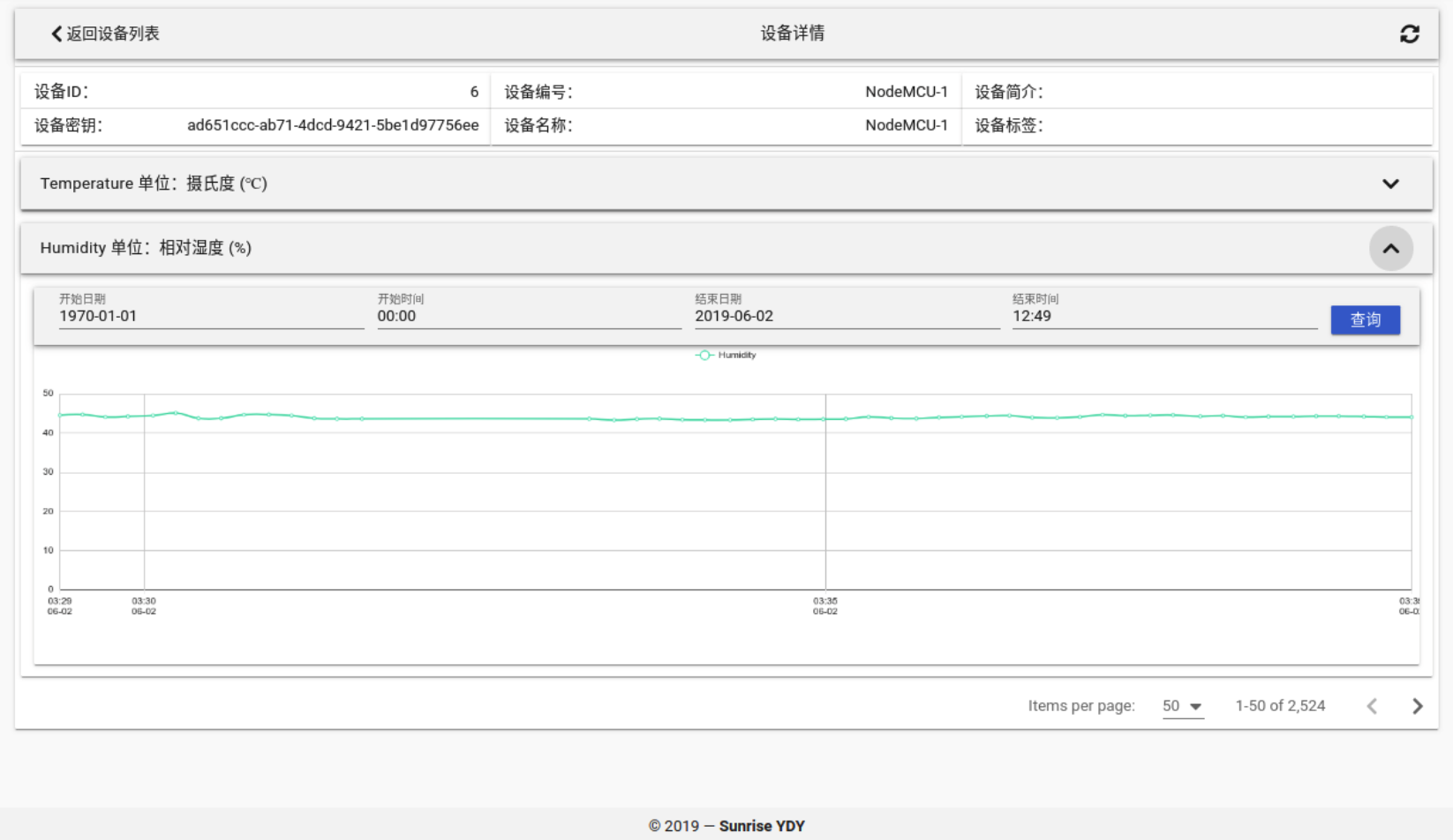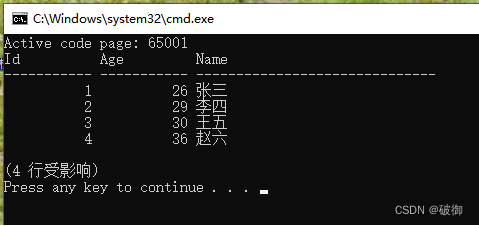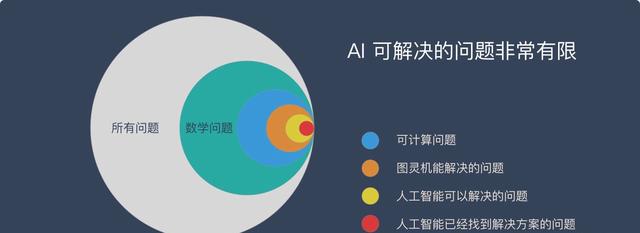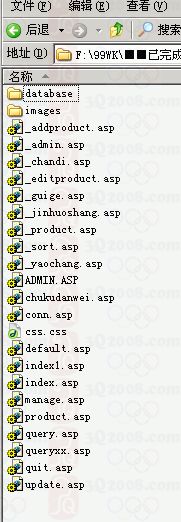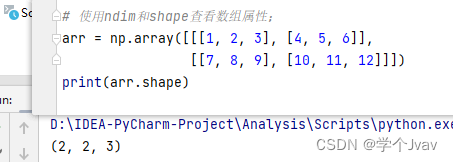纯检测系列:
YOLOv5-Openvino和ONNXRuntime推理【CPU】
YOLOv6-Openvino和ONNXRuntime推理【CPU】
YOLOv8-Openvino和ONNXRuntime推理【CPU】
YOLOv7-Openvino和ONNXRuntime推理【CPU】
YOLOv9-Openvino和ONNXRuntime推理【CPU】
跟踪系列:
YOLOv5/6/7-Openvino-ByteTrack【CPU】
YOLOv8/9-Openvino-ByteTrack【CPU】
分割系列:
YOLOv5_seg-Openvino和ONNXRuntime推理【CPU】
YOLOv8_seg-Openvino和ONNXRuntime推理【CPU】
关键点系列:
YOLOv7_pose-Openvino和ONNXRuntime推理【CPU】
YOLOv8_pose-Openvino和ONNXRuntime推理【CPU】
注:YOLOv5、YOLOv6和YOLOv7代码内容基本一致!YOLOv8和YOLOv9代码内容基本一致!
全部代码Github:https://github.com/Bigtuo/YOLOv8_Openvino
1 环境:
CPU:i5-12500
Python:3.8.18
2 安装Openvino和ONNXRuntime
2.1 Openvino简介
Openvino是由Intel开发的专门用于优化和部署人工智能推理的半开源的工具包,主要用于对深度推理做优化。
Openvino内部集成了Opencv、TensorFlow模块,除此之外它还具有强大的Plugin开发框架,允许开发者在Openvino之上对推理过程做优化。
Openvino整体框架为:Openvino前端→ Plugin中间层→ Backend后端
Openvino的优点在于它屏蔽了后端接口,提供了统一操作的前端API,开发者可以无需关心后端的实现,例如后端可以是TensorFlow、Keras、ARM-NN,通过Plugin提供给前端接口调用,也就意味着一套代码在Openvino之上可以运行在多个推理引擎之上,Openvino像是类似聚合一样的开发包。
2.2 ONNXRuntime简介
ONNXRuntime是微软推出的一款推理框架,用户可以非常便利的用其运行一个onnx模型。ONNXRuntime支持多种运行后端包括CPU,GPU,TensorRT,DML等。可以说ONNXRuntime是对ONNX模型最原生的支持。
虽然大家用ONNX时更多的是作为一个中间表示,从pytorch转到onnx后直接喂到TensorRT或MNN等各种后端框架,但这并不能否认ONNXRuntime是一款非常优秀的推理框架。而且由于其自身只包含推理功能(最新的ONNXRuntime甚至已经可以训练),通过阅读其源码可以解深度学习框架的一些核心功能原理(op注册,内存管理,运行逻辑等)
总体来看,整个ONNXRuntime的运行可以分为三个阶段,Session构造,模型加载与初始化和运行。和其他所有主流框架相同,ONNXRuntime最常用的语言是python,而实际负责执行框架运行的则是C++。
2.3 安装
pip install openvino -i https://pypi.tuna.tsinghua.edu.cn/simple
pip install onnxruntime -i https://pypi.tuna.tsinghua.edu.cn/simple
3 YOLOv8介绍
YOLOv8官网
YOLOv8原理
4 基于Openvino和ONNXRuntime推理
下面代码整个处理过程主要包括:预处理—>推理(框/mask)—>后处理(框/mask)—>画图。
假设图像resize为640×640,
前处理输出结果维度:(1, 3, 640, 640);
推理输出结果维度:检测头的输出(1, 116, 8400), 分割头的输出(1, 32, 160, 160);
首先对于一张 640x640 的图片来说,YOLOv8-Seg 模型存在两个输出,一个是 output0 可以理解为检测头的输出,它的维度是 1x116x8400;另一个是 output1 可以理解为分割头的输出,它的维度是 1x32x160x160,我们一个个来分析。针对于检测头的输出 1x116x8400 我们应该已经非常熟悉了,它代表预测框的总数量是 8400,每个预测框的维度是 116(针对 COCO 数据集的 80 个类别而言)
8400 × 116 = 80 × 80 × 116 + 40 × 40 × 116 + 20 × 20 × 116 = 80 × 80 × ( 84 + 32 ) + 40 × 40 × ( 84 + 32 ) + 20 × 20 × ( 84 + 32 ) = 80 × 80 × ( 4 + 80 + 32 ) + 40 × 40 × ( 4 + 80 + 32 ) + 20 × 20 × ( 4 + 80 + 32 )8400×116=80×80×116+40×40×116+20×20×116=80×80×(84+32)+40×40×(84+32)+20×20×(84+32)=80×80×(4+80+32)+40×40×(4+80+32)+20×20×(4+80+32) 8400×116=80×80×116+40×40×116+20×20×116=80×80×(84+32)+40×40×(84+32)+20×20×(84+32)=80×80×(4+80+32)+40×40×(4+80+32)+20×20×(4+80+32)
其中的 4 对应的是 cx, cy, w, h,分别代表的含义是边界框中心点坐标、宽高;80 对应的是 COCO 数据集中的 80 个类别置信度。32 维的向量可以看作是与每个检测框关联的分割 mask 的系数或权重。针对于分割头的输出 1x32x160x160,一个关键的概念是 prototype masks。它是一个固定数量(32)的基础 mask,每个 mask 的尺寸为 160x160。这些基础 mask 并不直接对应于任何特定的物体或类别,而是被设计为可以线性组合来表示任何可能的物体 mask。简单来说,模型不直接预测每个物体的完整 mask,而是预测一组基本的 masks(称为 prototype masks)以及每个物体如何组合这些 masks(权重/系数)。这种方法的好处是,模型只需要预测一个较小的 mask 张量,然后可以通过简单的矩阵乘法将这些小 mask 组合成完整的物体 masks。大家可以把它类比于线性代数中基向量的概念,空间中的任何一个向量是不是都可以表示为一组基向量的线性组合,那么其中的 prototype masks 即 32x160x160 的 mask 张量可以把它理解为一组基向量,而之前在检测框中的 32 维向量可以理解为组合这一组基向量的权重或者说系数。当我们从检测头得到一个 32 维的向量,分割头得到 32 个基础 masks 时,这个 32 维的向量实际上表示了如何组合这些基础 masks 来得到一个特定物体的 mask。具体来说,我们用这个 32 维向量对 32 个基础 masks 进行线性组合,从而得到与检测框关联的最终 mask。简单来说,这就像你现在有 32 种不同的颜料,检测头给你一个配方(32 维向量),告诉你如何混合这些颜料来得到一个特定的颜色(最终的 mask)。这样做的优点是我们不需要为每个检测框都预测一个完整的 mask,这个非常消耗内存和计算资源。相反,我们只需要预测一个相对较小的 32 维向量和一个固定数量的基础 masks,然后在后处理中进行组合即可。
后处理输出结果维度:boxes(-1, 6),其中第一个表示图bus.jpg检出的目标,第二个维度6表示(x1, y1, x2, y2, conf, cls);segments是各掩码轮廓点集。
4.1 全部代码
import argparse
import time
import cv2
import numpy as np
from openvino.runtime import Core # pip install openvino -i https://pypi.tuna.tsinghua.edu.cn/simple
import onnxruntime as ort # 使用onnxruntime推理用上,pip install onnxruntime,默认安装CPU# COCO默认的80类
CLASSES = ['person', 'bicycle', 'car', 'motorcycle', 'airplane', 'bus', 'train', 'truck', 'boat', 'traffic light','fire hydrant', 'stop sign', 'parking meter', 'bench', 'bird', 'cat', 'dog', 'horse', 'sheep', 'cow','elephant', 'bear', 'zebra', 'giraffe', 'backpack', 'umbrella', 'handbag', 'tie', 'suitcase', 'frisbee','skis', 'snowboard', 'sports ball', 'kite', 'baseball bat', 'baseball glove', 'skateboard', 'surfboard','tennis racket', 'bottle', 'wine glass', 'cup', 'fork', 'knife', 'spoon', 'bowl', 'banana', 'apple', 'sandwich','orange', 'broccoli', 'carrot', 'hot dog', 'pizza', 'donut', 'cake', 'chair', 'couch', 'potted plant', 'bed','dining table', 'toilet', 'tv', 'laptop', 'mouse', 'remote', 'keyboard', 'cell phone', 'microwave', 'oven','toaster', 'sink', 'refrigerator', 'book', 'clock', 'vase', 'scissors', 'teddy bear', 'hair drier', 'toothbrush']class OpenvinoInference(object):def __init__(self, onnx_path):self.onnx_path = onnx_pathie = Core()self.model_onnx = ie.read_model(model=self.onnx_path)self.compiled_model_onnx = ie.compile_model(model=self.model_onnx, device_name="CPU")def predict(self, datas):# 注:self.compiled_model_onnx([datas])是一个字典,self.compiled_model_onnx.output(0)是字典键,第一种读取所有值方法(0.11s) 比 第二种按键取值的方法(0.20s) 耗时减半predict_data = list(self.compiled_model_onnx([datas]).values()) # predict_data = [self.compiled_model_onnx([datas])[self.compiled_model_onnx.output(0)],# self.compiled_model_onnx([datas])[self.compiled_model_onnx.output(1)]]return predict_dataclass YOLOv8_seg:"""YOLOv8 segmentation model class for handling inference and visualization."""def __init__(self, onnx_model, imgsz=(640, 640), infer_tool='openvino'):"""Initialization.Args:onnx_model (str): Path to the ONNX model."""self.infer_tool = infer_toolif self.infer_tool == 'openvino':# 构建openvino推理引擎self.openvino = OpenvinoInference(onnx_model)self.ndtype = np.singleelse:# 构建onnxruntime推理引擎self.ort_session = ort.InferenceSession(onnx_model,providers=['CUDAExecutionProvider', 'CPUExecutionProvider']if ort.get_device() == 'GPU' else ['CPUExecutionProvider'])# Numpy dtype: support both FP32 and FP16 onnx modelself.ndtype = np.half if self.ort_session.get_inputs()[0].type == 'tensor(float16)' else np.singleself.classes = CLASSES # 加载模型类别self.model_height, self.model_width = imgsz[0], imgsz[1] # 图像resize大小self.color_palette = np.random.uniform(0, 255, size=(len(self.classes), 3)) # 为每个类别生成调色板def __call__(self, im0, conf_threshold=0.4, iou_threshold=0.45, nm=32):"""The whole pipeline: pre-process -> inference -> post-process.Args:im0 (Numpy.ndarray): original input image.conf_threshold (float): confidence threshold for filtering predictions.iou_threshold (float): iou threshold for NMS.nm (int): the number of masks.Returns:boxes (List): list of bounding boxes.segments (List): list of segments.masks (np.ndarray): [N, H, W], output masks."""# 前处理Pre-processt1 = time.time()im, ratio, (pad_w, pad_h) = self.preprocess(im0)print('预处理时间:{:.3f}s'.format(time.time() - t1))# 推理 inferencet2 = time.time()if self.infer_tool == 'openvino':preds = self.openvino.predict(im)else:preds = self.ort_session.run(None, {self.ort_session.get_inputs()[0].name: im}) # 与bbox区别,输出是个列表,[检测头的输出(1, 116, 8400), 分割头的输出(1, 32, 160, 160)]print('推理时间:{:.2f}s'.format(time.time() - t2))# 后处理Post-processt3 = time.time()boxes, segments, masks = self.postprocess(preds,im0=im0,ratio=ratio,pad_w=pad_w,pad_h=pad_h,conf_threshold=conf_threshold,iou_threshold=iou_threshold,nm=nm)print('后处理时间:{:.3f}s'.format(time.time() - t3))return boxes, segments, masks# 前处理,包括:resize, pad, HWC to CHW,BGR to RGB,归一化,增加维度CHW -> BCHWdef preprocess(self, img):"""Pre-processes the input image.Args:img (Numpy.ndarray): image about to be processed.Returns:img_process (Numpy.ndarray): image preprocessed for inference.ratio (tuple): width, height ratios in letterbox.pad_w (float): width padding in letterbox.pad_h (float): height padding in letterbox."""# Resize and pad input image using letterbox() (Borrowed from Ultralytics)shape = img.shape[:2] # original image shapenew_shape = (self.model_height, self.model_width)r = min(new_shape[0] / shape[0], new_shape[1] / shape[1])ratio = r, rnew_unpad = int(round(shape[1] * r)), int(round(shape[0] * r))pad_w, pad_h = (new_shape[1] - new_unpad[0]) / 2, (new_shape[0] - new_unpad[1]) / 2 # wh paddingif shape[::-1] != new_unpad: # resizeimg = cv2.resize(img, new_unpad, interpolation=cv2.INTER_LINEAR)top, bottom = int(round(pad_h - 0.1)), int(round(pad_h + 0.1))left, right = int(round(pad_w - 0.1)), int(round(pad_w + 0.1))img = cv2.copyMakeBorder(img, top, bottom, left, right, cv2.BORDER_CONSTANT, value=(114, 114, 114)) # 填充# Transforms: HWC to CHW -> BGR to RGB -> div(255) -> contiguous -> add axis(optional)img = np.ascontiguousarray(np.einsum('HWC->CHW', img)[::-1], dtype=self.ndtype) / 255.0img_process = img[None] if len(img.shape) == 3 else imgreturn img_process, ratio, (pad_w, pad_h)# 后处理,包括:阈值过滤+NMS+masks处理def postprocess(self, preds, im0, ratio, pad_w, pad_h, conf_threshold, iou_threshold, nm=32):"""Post-process the prediction.Args:preds (Numpy.ndarray): predictions come from ort.session.run().im0 (Numpy.ndarray): [h, w, c] original input image.ratio (tuple): width, height ratios in letterbox.pad_w (float): width padding in letterbox.pad_h (float): height padding in letterbox.conf_threshold (float): conf threshold.iou_threshold (float): iou threshold.nm (int): the number of masks.Returns:boxes (List): list of bounding boxes.segments (List): list of segments.masks (np.ndarray): [N, H, W], output masks."""x, protos = preds[0], preds[1] # 与bbox区别:Two outputs: 检测头的输出(1, 116, 8400), 分割头的输出(1, 32, 160, 160)# Transpose the first output: (Batch_size, xywh_conf_cls_nm, Num_anchors) -> (Batch_size, Num_anchors, xywh_conf_cls_nm)x = np.einsum('bcn->bnc', x) # (1, 8400, 116)# Predictions filtering by conf-threshold,不包括后32维的向量(32维的向量可以看作是与每个检测框关联的分割 mask 的系数或权重)x = x[np.amax(x[..., 4:-nm], axis=-1) > conf_threshold]# Create a new matrix which merge these(box, score, cls, nm) into one# For more details about `numpy.c_()`: https://numpy.org/doc/1.26/reference/generated/numpy.c_.htmlx = np.c_[x[..., :4], np.amax(x[..., 4:-nm], axis=-1), np.argmax(x[..., 4:-nm], axis=-1), x[..., -nm:]]# NMS filtering# 经过NMS后的值, np.array([[x, y, w, h, conf, cls, nm], ...]), shape=(-1, 4 + 1 + 1 + 32)x = x[cv2.dnn.NMSBoxes(x[:, :4], x[:, 4], conf_threshold, iou_threshold)]# 重新缩放边界框,为画图做准备if len(x) > 0:# Bounding boxes format change: cxcywh -> xyxyx[..., [0, 1]] -= x[..., [2, 3]] / 2x[..., [2, 3]] += x[..., [0, 1]]# Rescales bounding boxes from model shape(model_height, model_width) to the shape of original imagex[..., :4] -= [pad_w, pad_h, pad_w, pad_h]x[..., :4] /= min(ratio)# Bounding boxes boundary clampx[..., [0, 2]] = x[:, [0, 2]].clip(0, im0.shape[1])x[..., [1, 3]] = x[:, [1, 3]].clip(0, im0.shape[0])# 与bbox区别:增加masks处理# Process masksmasks = self.process_mask(protos[0], x[:, 6:], x[:, :4], im0.shape)# Masks -> Segments(contours)segments = self.masks2segments(masks)return x[..., :6], segments, masks # boxes, segments, maskselse:return [], [], []@staticmethoddef masks2segments(masks):"""It takes a list of masks(n,h,w) and returns a list of segments(n,xy) (Borrowed fromhttps://github.com/ultralytics/ultralytics/blob/465df3024f44fa97d4fad9986530d5a13cdabdca/ultralytics/utils/ops.py#L750)Args:masks (numpy.ndarray): the output of the model, which is a tensor of shape (batch_size, 160, 160).Returns:segments (List): list of segment masks."""segments = []for x in masks.astype('uint8'):c = cv2.findContours(x, cv2.RETR_EXTERNAL, cv2.CHAIN_APPROX_NONE)[0] # CHAIN_APPROX_SIMPLE 该函数用于查找二值图像中的轮廓。if c:# 这段代码的目的是找到图像x中的最外层轮廓,并从中选择最长的轮廓,然后将其转换为NumPy数组的形式。c = np.array(c[np.array([len(x) for x in c]).argmax()]).reshape(-1, 2)else:c = np.zeros((0, 2)) # no segments foundsegments.append(c.astype('float32'))return segmentsdef process_mask(self, protos, masks_in, bboxes, im0_shape):"""Takes the output of the mask head, and applies the mask to the bounding boxes. This produces masks of higher qualitybut is slower. (Borrowed from https://github.com/ultralytics/ultralytics/blob/465df3024f44fa97d4fad9986530d5a13cdabdca/ultralytics/utils/ops.py#L618)Args:protos (numpy.ndarray): [mask_dim, mask_h, mask_w].masks_in (numpy.ndarray): [n, mask_dim], n is number of masks after nms.bboxes (numpy.ndarray): bboxes re-scaled to original image shape.im0_shape (tuple): the size of the input image (h,w,c).Returns:(numpy.ndarray): The upsampled masks."""c, mh, mw = protos.shapemasks = np.matmul(masks_in, protos.reshape((c, -1))).reshape((-1, mh, mw)).transpose(1, 2, 0) # HWNmasks = np.ascontiguousarray(masks)masks = self.scale_mask(masks, im0_shape) # re-scale mask from P3 shape to original input image shapemasks = np.einsum('HWN -> NHW', masks) # HWN -> NHWmasks = self.crop_mask(masks, bboxes)return np.greater(masks, 0.5)@staticmethoddef scale_mask(masks, im0_shape, ratio_pad=None):"""Takes a mask, and resizes it to the original image size. (Borrowed fromhttps://github.com/ultralytics/ultralytics/blob/465df3024f44fa97d4fad9986530d5a13cdabdca/ultralytics/utils/ops.py#L305)Args:masks (np.ndarray): resized and padded masks/images, [h, w, num]/[h, w, 3].im0_shape (tuple): the original image shape.ratio_pad (tuple): the ratio of the padding to the original image.Returns:masks (np.ndarray): The masks that are being returned."""im1_shape = masks.shape[:2]if ratio_pad is None: # calculate from im0_shapegain = min(im1_shape[0] / im0_shape[0], im1_shape[1] / im0_shape[1]) # gain = old / newpad = (im1_shape[1] - im0_shape[1] * gain) / 2, (im1_shape[0] - im0_shape[0] * gain) / 2 # wh paddingelse:pad = ratio_pad[1]# Calculate tlbr of masktop, left = int(round(pad[1] - 0.1)), int(round(pad[0] - 0.1)) # y, xbottom, right = int(round(im1_shape[0] - pad[1] + 0.1)), int(round(im1_shape[1] - pad[0] + 0.1))if len(masks.shape) < 2:raise ValueError(f'"len of masks shape" should be 2 or 3, but got {len(masks.shape)}')masks = masks[top:bottom, left:right]masks = cv2.resize(masks, (im0_shape[1], im0_shape[0]),interpolation=cv2.INTER_LINEAR) # INTER_CUBIC would be betterif len(masks.shape) == 2:masks = masks[:, :, None]return masks@staticmethoddef crop_mask(masks, boxes):"""It takes a mask and a bounding box, and returns a mask that is cropped to the bounding box. (Borrowed fromhttps://github.com/ultralytics/ultralytics/blob/465df3024f44fa97d4fad9986530d5a13cdabdca/ultralytics/utils/ops.py#L599)Args:masks (Numpy.ndarray): [n, h, w] tensor of masks.boxes (Numpy.ndarray): [n, 4] tensor of bbox coordinates in relative point form.Returns:(Numpy.ndarray): The masks are being cropped to the bounding box."""n, h, w = masks.shapex1, y1, x2, y2 = np.split(boxes[:, :, None], 4, 1)r = np.arange(w, dtype=x1.dtype)[None, None, :]c = np.arange(h, dtype=x1.dtype)[None, :, None]return masks * ((r >= x1) * (r < x2) * (c >= y1) * (c < y2))# 绘框,与bbox区别:增加masks可视化def draw_and_visualize(self, im, bboxes, segments, vis=False, save=True):"""Draw and visualize results.Args:im (np.ndarray): original image, shape [h, w, c].bboxes (numpy.ndarray): [n, 6], n is number of bboxes.segments (List): list of segment masks.vis (bool): imshow using OpenCV.save (bool): save image annotated.Returns:None"""# Draw rectangles and polygonsim_canvas = im.copy()# Draw rectangles for (*box, conf, cls_), segment in zip(bboxes, segments):# draw contour and fill maskcv2.polylines(im, np.int32([segment]), True, (255, 255, 255), 2) # white borderlinecv2.fillPoly(im_canvas, np.int32([segment]), (255, 0, 0))# draw bbox rectanglecv2.rectangle(im, (int(box[0]), int(box[1])), (int(box[2]), int(box[3])),self.color_palette[int(cls_)], 1, cv2.LINE_AA)cv2.putText(im, f'{self.classes[int(cls_)]}: {conf:.3f}', (int(box[0]), int(box[1] - 9)),cv2.FONT_HERSHEY_SIMPLEX, 0.7, self.color_palette[int(cls_)], 2, cv2.LINE_AA)# Mix imageim = cv2.addWeighted(im_canvas, 0.3, im, 0.7, 0)# Show imageif vis:cv2.imshow('demo', im)cv2.waitKey(0)cv2.destroyAllWindows()# Save imageif save:cv2.imwrite('demo.jpg', im)if __name__ == '__main__':# Create an argument parser to handle command-line argumentsparser = argparse.ArgumentParser()parser.add_argument('--model', type=str, default='weights\\yolov8s-seg.onnx', help='Path to ONNX model')parser.add_argument('--source', type=str, default=str('bus.jpg'), help='Path to input image')parser.add_argument('--imgsz', type=tuple, default=(640, 640), help='Image input size')parser.add_argument('--conf', type=float, default=0.25, help='Confidence threshold')parser.add_argument('--iou', type=float, default=0.45, help='NMS IoU threshold')parser.add_argument('--infer_tool', type=str, default='openvino', choices=("openvino", "onnxruntime"), help='选择推理引擎')args = parser.parse_args()# Build modelmodel = YOLOv8_seg(args.model, args.imgsz, args.infer_tool)# Read image by OpenCVimg = cv2.imread(args.source)# Inferenceboxes, segments, _ = model(img, conf_threshold=args.conf, iou_threshold=args.iou)# Visualize, Draw bboxes and polygonsif len(boxes) > 0:model.draw_and_visualize(img, boxes, segments, vis=False, save=True)4.2 结果

具体时间消耗:
预处理时间:0.005s(包含Pad)
推理时间:0.012s(Openvino)
推理时间:0.014s(ONNXRuntime)
后处理时间:0.045s
注:640×640下。


